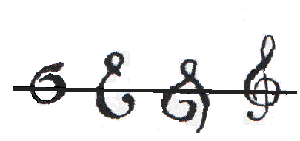RE: The History of Music: The Invention of Notation
Dear @mobbs,
astonishing post you wrote there. I think it's as ridiculous as unlikely but today I learned about this very topic in school. You wrote quite a few things I didn't hear about in class today. Mostly the clef development by Guido d'Arezzo I didn't know about yet, so thanks for that ;-)
Before I dive in let me excuse the formatting, I know it's terribly reader unfriendly, but I have forgot a lot of the tricks apparently.
Regarding the clefs I can give a little additional information: in your post you mentioned the C and the F clef, and included a picture which displays them in their today most commonly used form. What I think is really interesting how these clefs developed to look how they do today. I think the easiest to see it in the G clef, which apparently wasn't invented by Guido d'Arezzo. I'm sure everyone knows how it looks: 
Public Domain
I found pics on a blog which display the development: 
Source
I think you can see that the first one on the picture vaguely resembles a G, and how it slowly developed into the probably most used clef as of today.
The F clef is a little harder to imagine as an F if you look at it: 
Public Domain
If you look at the picture showing the development, it gets very clear: 
Source
Parts of the F just vanished and just left the two points behind, and the rest just curled up (just like the G clef) and now it looks like the well known clef. It's crazy, isn't it? =)
To add a little more musical context to all of this the G clef indicates where a G is in on the sheet of music, and to see it you just have to look where the clef "curls up". If a line passes through that, the G is right there. It is very very common for notation of singing parts, violin parts, the upper part of a piano notation etc. It is also known as treble clef.
For the F clef the F is pretty easy to see as it is just between the two points the horizontal lines of the letter F left behind. The F clef is used mostly for bass parts. Be it for an electric bass, a double bass, the left hand of a pianist or the bass in a choir.
The C clef isn't used very often, but it can be used can be used pretty often. As far as I know, if it is used, it is used either as a tenor or alto clef with the center of the clef being either on the line above the middle line or on the middle line respectively. Rarely you see in in choir music, it's not too unusual for orchestral instruments though.
Just a little fun fact to end my comment: the square neume notation is still sometimes seen if you sing in a church choir (I used to sing a few things written in it) so it hasn't entirely died out yet (I highly doubt anybody uses it for new music though)
Thanks again for your marvelous post, it's great to see such interesting topics brought up on Steem.
Hey great addition thanks!
Not only does it vaguely resemble a G, but it exactly resembles the G in the music image in my post above:
I'm certain I will be digging deeper into the clefs at a later point in this series!
I'm glad you appreciate it, it actually took me a while to put the class this is based on into words of much more detail and format